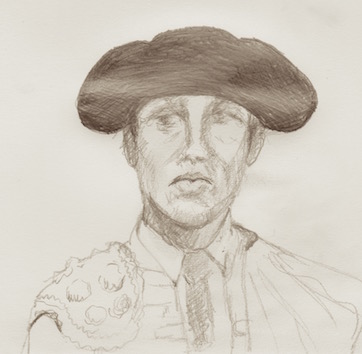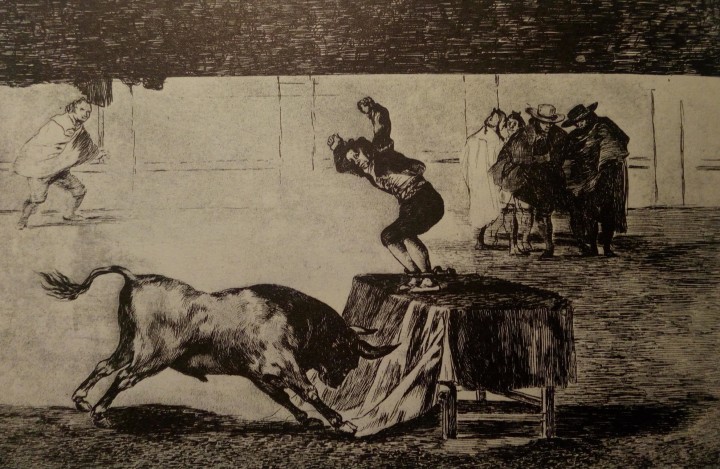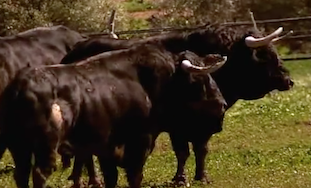Born in 1834 and deaf mute since birth, Daniel Perea was an spanish artist focused on bullfighting . He ilustrated with his drawings many of the 19th century spanish newspapers and magazines . Perea created “A Los Toros” a series of 28 original watercolors with texts that explain in Spanish, English and French the different stages of the bullfight.. 

Archivo por meses: febrero 2017
Gomez del Pilar in Madrid
Noé Gómez Rodriguez, known as Gomez del Pilar, was born in Madrid in 1988 and fight for the first time as Novillero in Illescas ( Toledo) on March 1st 2009 with Sergio Pulido and Carlos Durán against bulls from El Cortijillo.
He fight in Las Ventas Bull Ring on April 11th 2010 with Román Marcos “El Pela” and Ignacio González. He obtained the stanting of Matador de Toros in Añover de Tajo (Toledo) with Juan José Padilla and Eugenio de Mora and bulls from Luis Algarra on August 27th 2013:
Gomez del Pilar will confirm the Alternativa ( his standing of Matador ) in Madrid on April 9th 2017.

Watercolors by Daniel Perea

 Born in 1834 and deaf mute since birth, Daniel Perea was an spanish artist focused on bullfighting . He ilustrated with his drawings many of the 19th century spanish newspapers and magazines . Perea created “A Los Toros” a series of 28 original watercolors with texts that explain in Spanish, English and French the different stages of the bullfight..
Born in 1834 and deaf mute since birth, Daniel Perea was an spanish artist focused on bullfighting . He ilustrated with his drawings many of the 19th century spanish newspapers and magazines . Perea created “A Los Toros” a series of 28 original watercolors with texts that explain in Spanish, English and French the different stages of the bullfight..
Drawings by Manuel Castellano
These extraordinary drawings by the spanish artist Manuel Castellano are in Madrid ( National Library ) .
Manuel Rodríguez de la Parra Castellano (3 February 1823/26, Madrid – 3 April 1880, Madrid) was a Spanish costumbrista painter and engraver in the Romantic style, known especially for his bullfight scenes. He was also a noted art collector.
He began his art studies at the Academia de Bellas Artes de San Fernando in Madrid and later worked with Carlos Luis Ribera to decorate the ceiling of the meeting room for the Congress of Deputies.
In 1856, he won honorable mention at the first National Exhibition of Fine Arts for his painting of the picadors preparing their horses at the old bullring in Madrid (demolished in 1874), which incorporates portraits of many of the period’s most popular bullfighters, including Paquiro.
In 1862, he won third prize at the Exhibition with his depiction of the deaths of Luis Daoíz and Pedro Velarde; again in 1866 for Fernando Valenzuela in prison, and a third time in 1868 for the death of the Conde de Villamediana. In 1875, aged almost fifty, he was awarded a stipend to study in Rome and Venice. He also studied briefly in Paris.[1]
As a collector, he acquired one of the first collections of photographs in Spain. He amassed more than 20,000 of them, from 1853 until his death, primarily portraits and scenic vistas, most of which were arranged in albums. After his death, they passed into the collection of the Biblioteca Nacional. His nephew sold over 6,000 engravings from his uncle’s collection to the museum.


Alberto Aguilar in Madrid on April 9th
 Alberto Aguilar was born in Madrid in 1986 .He started to study at the Taurine School in Madrid on October 5th, 1998. His teachers were Carlos Neila, José Luis Bote, Serranito and Joaquín Bernadó. He fought his first calf in Castilforte (Guadalajara) on August 2nd, 1999. That same year he won the Calf Cycle Competition held in Pozuelo del Rey (Madrid).
Alberto Aguilar was born in Madrid in 1986 .He started to study at the Taurine School in Madrid on October 5th, 1998. His teachers were Carlos Neila, José Luis Bote, Serranito and Joaquín Bernadó. He fought his first calf in Castilforte (Guadalajara) on August 2nd, 1999. That same year he won the Calf Cycle Competition held in Pozuelo del Rey (Madrid).
In 2000 he made his debut in public in El Batán on July 15th with Novillos from Rocío Sebastián Erice. In 2001 he fought dressed in bullfighter costume for the first time in Las Matas (Madrid) against bulls of Víctor Aguirre being rewarded with three ears. That same year he fought a total of 33 calves, with important triumphs in Dax and Bayona,
On January 4th he participated in Vistalegre, with Novillos ofrom Pablo Mayoral and Mercedes Figueroa, being awarded with two ears.
That same season he compited at VI National Contest of Novilladas. He also fought in Las Ventas Bullring on March 2n in a festival for the victims of the Prestige, with Luis Francisco Esplá, Francisco Rivera Ordonez, Manuel Caballero, Julio Aparicio, Uceda Leal.
His debut in a Novillada with Picadores was on July 23, 2003, in Villalba (Madrid) with Javier Solis and Luis Bolívar and Novillos from Angel Luis Peña. He was awarded with three ears. The season ends with eight novilladas.
In2004 season, he fights a total of 20 Novilladas and awarded with 22 ears and one tail,.
In 2005 he completes his best season as a Novillero, acting in 33 Novilladas , participating in the main Ferias . He was awarded with one ear on May 16th in Madrid.
On August 13th 2006 he obtained the standing of Matador de Toros in Miraflores de la Sierra, , with Ivan Vicente as Padrino (Godfather) and El Capea as Testigo (witness ) and was awarded with three ears. The 2009 season was truncated by a serious knee injury, which prevented him from being able to fight for a long time.
In the last years he have improved his skills as a bullfighter very much and we are looking forwart to seeing him fighting in Madrid on April 9th.
The Bullfighter Martincho
 “Another Of His Follies In The Same Bull Ring” (“Otra locura suya en la misma plaza”)this is the title of this splendid engraving by Goya. It represents a chilling episode . Martincho, famous bullfighter, standing on a table with feet tied seems to be ready to jump over the bull. Martincho was a brave , sometimes reckless, bullfighter capable of the greatest audacies. Goya printed this work in 1815 . Especially interesting is the group of people in the background
“Another Of His Follies In The Same Bull Ring” (“Otra locura suya en la misma plaza”)this is the title of this splendid engraving by Goya. It represents a chilling episode . Martincho, famous bullfighter, standing on a table with feet tied seems to be ready to jump over the bull. Martincho was a brave , sometimes reckless, bullfighter capable of the greatest audacies. Goya printed this work in 1815 . Especially interesting is the group of people in the background
Francisco Ebassún Martinez or Francisco Antonio Bassón martines, better known as MARTINCHO (1708-1772) was a bullfighter from Aragón . He was specialized in facing the bulls with shackles on his feet. He got the stanting of Matador de Toros in Madrid in 1750 . When Francisco de Goya was 18 years old , he saw Martincho fighting . Long after his engravings represented the feats of Martincho.
Banderillas Al Cuarteo
The main objective of the Stage of “Banderillas” is to revive the bull
without reducing its strength in order to prepare it for the next stage: The
Stage of Muleta (Suerte de Muleta).
Three bullfighters’ assistants or sometimes the bullfighter him or herself
jab the bull’s back with three pairs of “Banderillas”. The bull feels a
sharp pain when the “Banderillas” have pierced its back.
The Suerte del Cuarteo is one of the oldest way to jab the bull with the banderillas. The bullfighter faces the bull and moves describing a semicircle getting the bull to move towards him. The bullfighter Pepe-Hillo, main carácter of many Goya’s engravings, described the Banderillas al Cuarteo:
“El diestro se colocará a una distancia proporcionada, ya se halle el toro parado, ya venga levantado, y llamándole partirá de sesgo para encontrarse con el toro, el cual tomará necesariamente el mismo giro en busca del torero. Luego que éste se haya reunido con aquél en el centro de la suerte, se quedará para meterle las banderillas en el cerviguillo en el mismo acto que baje la cabeza para dar la embestida”
However this is not the only way to jab the bull. Sometimes the bullfighter does not move and wait the charge of the bull. Examples of this technique are the “Topacarnero” and the “Quiebro”.


History of the Montera
FUENTE YMBRO IN MADRID
 The Fuente Ymbro’s bulls live and grow in Lo Romeral, a big meadow located in the province of Cadiz , between the cities of San Jose del Valle and Alger, very close to the Natural Park Los Alcorocales. These bulls are very well fed and live in freedom like any other wild animal.
The Fuente Ymbro’s bulls live and grow in Lo Romeral, a big meadow located in the province of Cadiz , between the cities of San Jose del Valle and Alger, very close to the Natural Park Los Alcorocales. These bulls are very well fed and live in freedom like any other wild animal.
The owner of these prestigious fighting bulls is Ricardo Gallardo.
Fuente Ymbro’s bulls , usually black and Brown, serious and with big face, are very demanded by the most famous bullfighters.
We are going to have the opportunity to see in action these bulls in Madrid on March 26th 2017.
LEO VALADEZ
On March 26th 2017 Leo Valadez, Diego Carretero and Pablo Aguado will fight in Madrid against bulls from Fuente Ymbro. The public of Madrid is looking forward to seeing Leo Valadez, one of the most interesting Mexican bullfighters today
Leo Valadez was born in 1997 in Aguascalientes, Mexico. He studied at the Aguascalientes School and at the Fundación El Juli, in Arganda. Leo was the first student to get a scholarship from CITAR ( Centro Internacional de Tauromaquia y Alto rendimiento). He fighted for the first time on June 9th 2013 with Francisco Jose Espada and Cristian Climent against bulls from Antonio Lopez Gibaja.
Technically he handles very well l the Muleta with the left hand, uses aristically the cape and , sometimes , plays the roll of a Banderillero.
Leo Valadez has in the great Mexican bullfighters his great references. “I learn watching his videos, especially David Silveti and Manolo Martinez, are my two favorite bullfighters. It’s time for Mexico to have a new great bullfighter and I will fight to be him. “. He dreamed with fighting at the most importat european bull-rings, but he never forgets Mexico: “I am proud to be Mexican and having success at home will make me very happy.”


